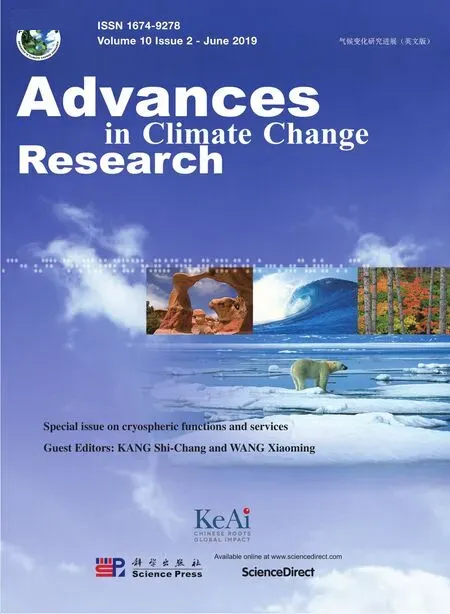Cryospheric functions and services
2019-03-14KANGShi-Chang,WANGXiaoming
The cryosphere is the sphere around the Earth that has a certain thickness, existing at a temperature below 0°C, and it comprises components mainly including glaciers, ice sheets,snow cover, permafrost, lake and river ice, sea ice, and ice shelves.It is regarded as one of spheres in the climate system,and well known for its sensitivity to climate change. Cryospheric science is an interdisciplinary subject related to all cryospheric components and is also linked to other earth sciences, including studies of the atmosphere, hydrosphere,biosphere, lithosphere, and anthroposphere (Qin et al., 2017).The integration of cryospheric science and social science has recently attracted considerable attention owing to the progress using systematic approaches on both basic and applied research of cryospheric changes (Qin et al., 2017). Studies have highlighted the significant roles of cryospheric science in understanding climate changes as well as sustainable development under the changes. Among them, it provides the understanding of mechanisms and processes in association with the interactions among the cryosphere,climate,and ecosystem in sustainable development. This editorial issue presents the recent research on cryosphere change and its effects on sustainable development, with a particular focus on cryospheric functions and services, which are categorized into provisioning, regulating, cultural, and supporting services.
Global warming has been causing the retreat of glaciers that has a considerable influence on societies at all levels, thereby impacting the cultural service provided by glaciers.Wang and Zhou (2019) explained in details on how climate change accelerates the glacier retreat, affects tourism,and compromises sustainable development in the mountainous regions. The study suggested that climate change is the most challenging factor for glacier tourism in the 21st century.Considering that glaciers are one of the most important tourism resources in the mountainous regions, adaptation integrated with sustainable development strategy has to be implemented for improving glacier tourism.
By supporting the ecosystem, the permafrost plays key roles on its service aspect. Using a process-based ecosystem model,Yi et al.(2019)analyzed the carbon dynamics of alpine grasslands in the Qinghai-Tibetan Plateau (QTP) under different representative concentration pathways. They indicated that the responses of alpine grasslands (i.e., increase in vegetation and carbon) is most likely attributed to CO2fertilization. Furthermore, it was identified that the loss of impermeable layers made of permafrost reduced the growth of plant and vegetation. Xu et al. (2019) took a step further to investigate the ecosystem services in relation to the permafrost in China, focusing on the zonation of ecosystem services in the permafrost regions. The study applied a three-hierarchy zoning framework for ecosystem services by establishing zoning goals, principles, hierarchy, methodology, and nomenclature. Based on GIS spatial tools together with location entropy analysis for the assessment of ecosystem services,Xu et al. (2019) evaluated the ecosystem status, ecosystem service supply, and beneficiaries.
The supporting service of permafrost can also be demonstrated using its engineering functions. Xu and Wu (2019)investigated evolution of permafrost in relation to the mean annual ground temperature(MAGT)in the historical period of 1950-2005 and projected period of 2006-2099. Subsequently, an allowable bearing capacity was analyzed for the areas in the QTP. In response to the increasing MAGT of 0.36°C during 1950-2005, it was found that the permafrost area would decrease by 0.232 × 106km2(RCP2.6),0.468 × 106km2(RCP4.5), 0.564 × 106km2(RCP6.0), and 0.803 × 106km2(RCP8.5) during 2006-2099. The decrease may further reduce the allowable bearing capacity in the permafrost zones.
One of the key cryospheric services is the provisioning of water resources. In fact, snow cover is providing an essential service for human wellbeing and socio-economic development in arid areas. However, global warming is degrading snow cover and substantially reducing the value of snow services to meet the demands of socio-economic activities. Yang et al.(2019) found that there was an average decline in the mass of snow cover from 1979 to 2016 in the Irtysh River Basin in the Altai Mountain. They evaluated the loss of snow cover in relation to the service for water resources. Yang et al. (2019)clearly showed that reduction in snow cover would considerably influence socio-economic development and environmental conservation that relies on the services provided by snow cover.
Lin et al. (2019) synthesized the understanding of the cryospheric services via an approach using regionalization that considers both natural and socio-economic aspects of cryospheric characteristics. By using the supply-demand model with an aim to maximize overall cryospheric services, Lin et al. (2019) established a classification system for services,identified their spatial distribution pattern, and developed its comprehensive zonation.
Finally,Wang et al.(2019)developed a unified approach to assess both risks and services of the cryosphere under the influence of climate change. They highlighted pathways to minimize the risks posed to societies that were exposed to cryospheric hazards, while maximizing the benefit of cryospheric services by managing natural capitals and demands in conjunction with enhancing the cryosphere's utility. Wang et al. (2019) further investigated how cryospheric services contribute to sustainable development, particularly in relation to sustainable development goals.
With the hope that all articles in this collection will enjoy a broad readership, we would like to take this opportunity to improve the scientific understanding of cryospheric change and its impact on sustainable development.We intend to create an initiative that can assist in the development and implementation of sustainable development strategies for the global environment as well as the wellbeing of our societies.
Conflict of interest
The authors declare no conflict of interest.
杂志排行
Advances in Climate Change Research的其它文章
- A new look at roles of the cryosphere in sustainable development
- A preliminary study on the theory and method of comprehensive regionalization of cryospheric services
- Valuating service loss of snow cover in Irtysh River Basin
- Impact of climate change on allowable bearing capacity on the Qinghai-Tibetan Plateau
- An ecosystem services zoning framework for the permafrost regions of China
- Modeling the carbon dynamics of alpine grassland in the Qinghai-Tibetan Plateau under scenarios of 1.5 and 2 °C global warming
